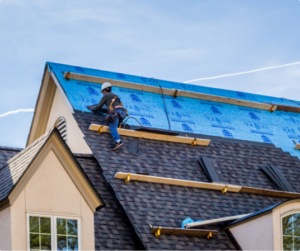How to Choose and Install Roofing
Roofing is the process of covering a building with a protective layer. It consists of the various materials, constructions, and layers of the building envelope, which protects the interior from the outdoors. It is a critical component of a building’s overall design. Contact Roofing and Gutters to learn some tips for choosing a roof. Also, you can learn how to make it last for a long time by following these guidelines. Now that you know the basics, you’re ready to get started.
To install a shingle roof, you should run the shingles over the edge of the roof. Use a utility knife with a hook blade to trim any shingles that are too long. If you end up with an overhang that exceeds one foot, you can cut it off and use it on another part of the roof. Be sure to keep in mind that it’s important to make sure you lay shingles evenly so that they will not overlap.
While a gable roof is easy to measure, a gambrel or mansard roof is a bit more complicated. These intricate roofs tend to produce more waste because the shingles must be cut to fit the tight spaces and be nailed in rows to form even roof decks. This waste leads to more wasted material than you originally thought. The phrase “roof square” is useful in bridging the gap between simple projects and complex ones.
Roofing is an integral part of a building’s construction. Without a good roof, the entire construction quality of the building will be questioned. Getting a reliable roofer is critical. A reliable roofer will ensure the building’s roof does not leak and is of high quality, which complements the building’s overall appearance. It also protects the mechanical systems of the building. And, if you’re selling the house, a good roof will also increase the value of the property.
Roofing materials vary in strength and durability. For example, there are two types of asphalt roofs: mineral-surfaced and granule-surfaced. Mineral-surfaced shingles, which are applied over old asphalt shingles, are referred to as “nesting.” These shingles are butted against the tab of the old shingles, which increases their adhesion. Another type of asphalt roof cement is called “flashing cement.” This type of cement is made of asbestos-free asphalt.
Roofs provide protection from the elements and are an excellent source of insulation. Fibrous roofing materials, such as felt, provide high-quality insulation. Plastic sheeting can also be reflective and is often installed directly underneath the other roofing material. Using recycled paper products or synthetic foam batting to fill in the cavities of a roof is an excellent way to make it energy-efficient. These options also prevent ice and snow from accumulating around chimneys.
If you are in need of a new roof, be sure to plan ahead. Keep an emergency fund of at least 10% of the cost of the new roof. This way, you can pay for repairs while on vacation. You’ll know you won’t have to worry about a leak in your home, and you’ll be able to enjoy yourself. When your home suffers damage from weather, you can use the money to cover the repairs.
The first tip for identifying leaks is to check the attic for rotting wood. Using a flashlight, check for rotting wood by pressing on the darkened sheathing. If it’s giving way, this could be an indication of a compromised roof. Roofing is an essential part of your home’s interior design. You should not put your house at risk for damage from hail or water. If you notice any of these warning signs, it’s time to contact a roofing contractor and get a roof inspection.
During the winter, there are several ways to prevent water from penetrating the roof, including using underlayment. Underlayment is a protective layer that binds together the shingles and supports them. It also prevents water from seeping through the shingles and into the house. If you’re in an area with severe climates, make sure you install an ice barrier at least three to six feet above the eave. In most cases, building codes require that this barrier extends at least two feet past the exterior wall.
Depending on your climate, there are a few different types of metal used for roofing. They all vary in price and lifespan. Among the metals most often used for roofing are steel, zinc, copper, aluminum sheeting, and copper. All of these have different qualities and costs. You should research which one is best for your home. Roofing companies can help you choose the right material for your project. Then, you can make an informed decision based on the needs of your budget.
